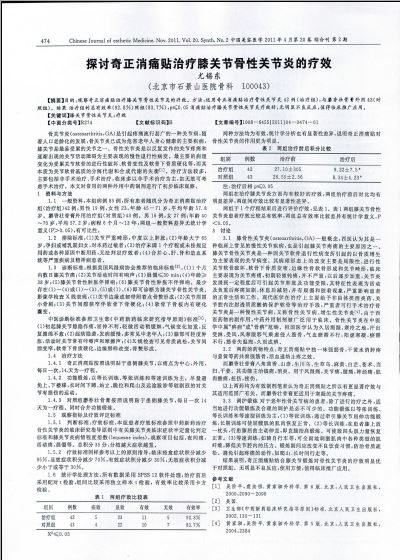联合DWI和MRA在早期脑梗塞诊断中的价值(1)
 |
| 第1页 |
参见附件(2074KB,2页)。
【摘要】目的:评价联合磁共振弥散成像(DWI)和血管成像(MRA)在早期脑梗塞诊断中的价值。方法:118例早期脑梗塞患者全部行常规MRI、DWI及MRA检查。结果:48例超急性期脑梗塞病人DWI全部显示为高信号,27例在T1WI、T2WI及FLAIR均为正常;21例T1WI未见异常,T2WI及FLAIR呈稍高信号影。70例急性期脑梗塞病例,DWI、T2WI及FLAIR序列显示为高信号、略高信号,T1WI序列显示为低信号、略低信号。在118例磁共振脑血管成像(MRA)中,15例表现为正常,103例发现血管异常,表现为动脉闭塞、狭窄和硬化。结论:联合应用DWI和MRA能及时准确的诊断出早期脑梗塞,也有利于早期合理的治疗方案的制定及预后判断。
【关键词】弥散成像;磁共振血管成像;早期脑梗塞
【中图分类号】R743.3【文献标识码】B【文章编号】1008-6455(2011)04-0484-02
The value of diagnosing in early cerebral infarction combined DWI with MRA
Gong Xuepeng1 Zhu Wangdong1 Cai Dongshun1 et al.
【Abstract】Objective:To evaluate the value of application of DWI and MRA in diagnosing early cerebral infarction.Methods:118 cases of early cerebral infarctionwere scaned by MRI.The sequences included T1WI, T2WI, FLAIR ,DWI and MRA. Results:48 cases of super-acute cerebral infarction on DWI all were displayed abnormal high signal. 70 cases of acute cerebral infarction displayed slightly high signal or high signal in T2WI ,FLAIR and DWI.and displalyed low or slightly lower signal in T1WI. In scaned with MRA, 18 cases displayed normal,70 cases displayed abnormal such as partly deficiency, focal stenosis and sparseness of the cerebral artery. Conclusion:?DWI combined with MRA can rapidly and accurately detect early cerebral infarction.It can provide more information and better strategies for patients with early cerebral infarction.
【Key words】diffusion-weighted imaging; magnetic resonance angiography; early cerebral infarction
脑梗塞是第三位致死和首要致残的人类常见多发疾病,早期诊断并及时溶栓治疗,多数病变可以恢复,病人的功能得到保护,减少死亡和致残率[1]。本文回顾分析118例早期脑梗塞患者的常规MRI、DWI及MRA检查资料,探讨联合应用DWI和MRA诊断早期脑梗塞的临床价值。
1 方法
1.1 临床资料:收集我院2010年2月~2011年1月期间检查资料完整的早期脑梗塞患者118例,其中男73例,女45例,年龄45~81岁,平均56.5岁。发病时间全部在3d以内,临床主要症状为突发头晕、头痛、言辞不清、失语、偏侧肢体麻木无力等。按照发病到MRI扫描时间区分:超急性期(<6小时)48例,急性期(6小时-3天)70例。全部病例在行头颅MRI扫描前均已行CT扫描除外脑出血等。
1.2 使用设备及扫描参数:使用Siemens Symphony P 1.5T超导MR机,用正交头部线圈行常规MRI及平面回波(EPI)弥散加权成像(DWI)和MRA。常规MRI包括T1WI/SE(TR/TE500ms/8.1ms) 、T2WI/TSE(TR/TE5550.0ms/104.0ms) 及FLAIR(TR/TE8080.0ms/92.0ms)序列。DWI采用单次激发EPI脉冲序列行横轴面扫描(TR/TE4100ms/119ms):层厚为5.0mm、间隔1.5mm, 加脂肪抑制,视野(FOV)23.0cm×23.0cm,矩阵为128×128,分别在层面选择、相位编码和频率编码方向上加弥散敏感梯度 ......
您现在查看是摘要介绍页,详见PDF附件(2074KB,2页)。